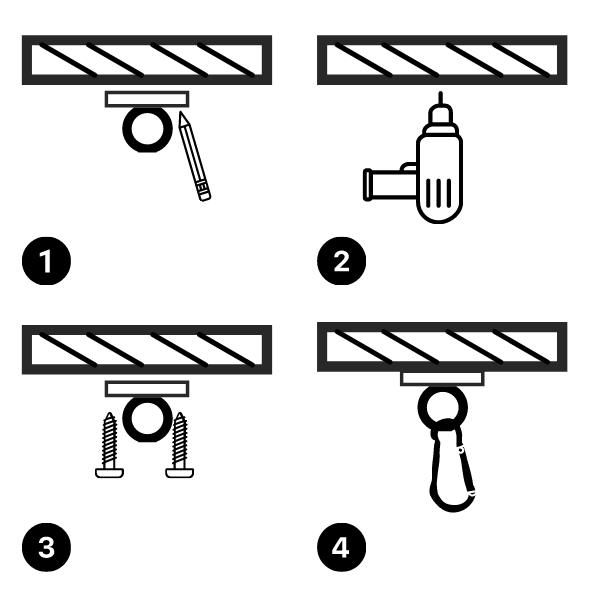Disclaimer: As an affiliate I may earn a commission on any qualifying purchases, including those from Amazon.com, at no extra cost to you – read more.
Once you get a taste of hammock life, trust me when I say that you’ll want to hang them everywhere. Hanging a hammock outside is relatively straightforward, especially if you have trees. However, you need to be more careful when hanging them inside.
In this guide, I’ll share some tips for hanging your hammock without damaging your walls or drilling into them.
Is It Safe to Hang a Hammock Indoors?
Yes, it’s perfectly safe to hang your hammock indoors providing you are sensible about the placement of the anchor points. You should make sure that you’re drilling the anchor points into a wall stud and not into dry plasterboard.
Whilst this is easy enough to do, if you’re not confident in your DIY skills or don’t want to leave any lasting traces of the hammock (applies to rental accommodation), there are three other ways you can hang a hammock as shared below.
How to Hang a Hammock Indoors Without Damaging Walls
There are three main ways you can hang a hammock indoors without drilling into the walls: hang it from an existing post or pillar, use a hammock stand, or hang it from the ceiling. The latter option will involve some drilling into the ceiling.
Here is more information about each hanging method and when it’s most suitable:
1. Hang from existing posts or pillars
The first thing to look for when planning to hang your hammock inside without damaging any walls is for existing objects that can be used to hang it from.
The most common object is a ceiling beam, these are very popular in older buildings and allow you to wrap the rope or straps around the beam like shown in this picture.
You can also look out for:
- Pillars
- Posts
- Poles
- Stair rails
- Balcony railing

Again, it is more likely that you’ll have something suitable in older houses, whereas modern houses are built to a certain standard.
You should try to use permanent fixtures that are part of the house and avoid objects like cabinets or home appliances. These may seem sturdy to begin, but over time the weight will cause them to move and may end up running your floor in doing so.
2. Use a hammock stand
If you want to hang a hammock indoors without drilling, then you’re the best option is to invest in a hammock stand. This requires no DIY skills and removes any risk of causing damage to your home.
Hammock stands are available in all sorts of shapes and sizes. I’d recommend opting for a steel stand that can easily be moved or put away. These portable stands tend to be much cheaper than wooden stands too.
My top pick is the Sunny Daze Universal Stand which has a high weight capacity of 550lbs and is suitable for a broad range of hammocks.
If you don’t have a huge amount of space, the Vivere Space Saving Stand is a great alternative with a slim profile that’s ideal for small spaces or balconies.
If you would prefer a more permanent and better-looking stand like the one shown here, see my full guide to the best wooden hammock stands.

3. Hang it from the ceiling
The third option to avoid damaging your walls is to create anchor points on your ceiling for hanging your hammock. This is better if you don’t want to invest in a hammock stand and are comfortable with a bit of DIY.
This step will require some drilling, although it will be into the ceiling rather than your walls. You’ll need to purchase a hammock hanging kit such as this diamond hook and carabiner set. I recommend hooks that have at least 4 screws as this distributes the weight more evenly.
The hanging distance will depend upon the height of the ceiling and the length of your hammock. Find more details on hanging a hammock from the ceiling below.
How to Hang A Hammock From the Ceiling
Below are the steps to follow to hang your hammock from the ceiling.
I should note that it’s not advised to hang it from the ceiling if you have a false ceiling in place. You should be screwing the hooks directly into the ceiling joists.
Before you begin, you’ll need to calculate the required distance between the two anchor points. There is a very helpful hammock hang calculator here. This will also tell you how much suspension cord you’ll need to achieve your desired sag and ground clearance.

- Locate the ceiling joist (aka ceiling stud) you wish to hang the hammock from.
If hanging beneath the attic, you can head into the attic to help find the joists. If you’re hanging it on another floor, it’s best to use a stud finder.
- Drill the required holes for the anchor point.
Before drilling, it’s best to use a pencil to mark on the ceiling where the screw holes need to be as shown in this diagram.
- Screw the anchor point to the ceiling.
Ensure to use the correct screws for the material you’re screwing the anchor points to. It will most likely be wooden joists in the ceiling so use the appropriate screws.
- Hang and test your hammock.
If you’ve not hung anything substantial from your ceiling before, you should test the hammock with some heavy objects before using it yourself.
This is to test both the integrity of your hanging skills and the strength of the ceiling itself. Whilst you are very unlikely to cause any immediate damage, keep an eye out for any sag in the ceiling over time caused by the hammock.
How Much Weight Can an Indoor Hammock Hold?
The amount of weight an indoor hammock can hold is the maximum capacity of either the hammock itself, the hammock stand, or the anchor point equipment, whichever is the lowest.
If you are hanging your hammock from the ceiling, you should also keep in mind the load your ceiling can bear. This will vary depending upon several factors such as:
- The thickness of the ceiling studs – These tend to be 2”x6” in most modern homes. If they are much smaller than this, you should reconsider hanging a hammock from the ceiling.
- Length of the ceiling studs – The longer the ceiling stud, the less weight it can hold. For this reason, you are better hanging your hammock in a smaller room.
- Placement of the hammock – It’s safest to hang your hammock near the edge of the room where the studs are strongest. I would not recommend hanging your hammock in the middle of a room.
- Weight on the floor above – The best place to hang a hammock is directly underneath your attic which tends to be supporting the least weight anyway.
Once you have hung your hammock, it’s best to gradually test the integrity of your work. Slowly pile on some heavy objects and if everything is fine, you can ease yourself into it.
If in doubt, you can always ask a local handyman to come and help you out.
How Far Apart Should Hammock Anchor Points Be?
I referred to a calculator earlier which is the best place to find an exact hanging distance for your hammock. The calculator is suitable for both hanging from two points and hanging from a ceiling.
However, here is a rough guide based on a 9’4ft hammock (ENO SingleNest):
Hanging at 6ft high: you will need to hang it 15’7ft apart with 4’4ft of suspension rope on each side.
Hanging at 7ft high: you will need to hang it 19’1ft apart with 6’4ft of suspension rope on each side.

